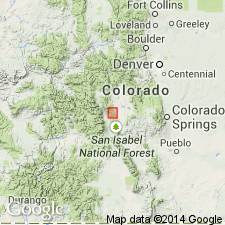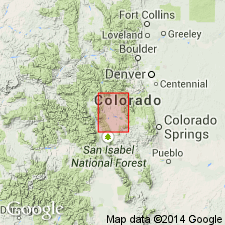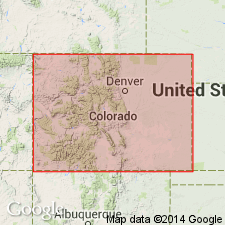
- Usage in publication:
-
- Coffman conglomerate member
- Modifications:
-
- Original reference
- Dominant lithology:
-
- Sandstone
- Shale
- Conglomerate
- AAPG geologic province:
-
- Eagle basin
- South Park basin
Summary:
Pg. 971-1009; Fig. 1 (geol. map). Coffman member of Maroon formation. Arkosic conglomerate with interbedded shale and sandstone. Conformably underlies Chubb siltstone member and conformably overlies Weber(?) formation in Salt Creek area, Park and Chaffee Counties, central Colorado. Thickness 20 to 1,000 feet. Is 615 feet thick at type section, 1,000 feet thick about 1 mile east of type section, and only 20 feet thick in Chubb Gulch [now Chubb Park]. Fossil plant impressions, from near base, identified as CALAMITES and LEPIDODENDRON (by David White, written commun. to J. Harlan Johnson, October 28, 1933). Age is considered Pennsylvanian(?).
Type section: measured in unnamed valley about 2 mi north of Coffman Park, in sec. 24, T. 13 S., R. 77 W., [Antero Reservoir 7.5-min quadrangle, near Chaffee-Park Co. line], central CO. Named from Coffman Park, in southeastern part of area. [Coffman Park now called Kaufman Pasture.]
[Additional locality information from USGS historical topographic map collection TopoView, USGS GNIS database, and ACME Mapper 2.0, https://mapper.acme.com/; accessed May 11, 2018.]
Source: Publication; US geologic names lexicon (USGS Bull. 896, p. 483).
- Usage in publication:
-
- Coffman conglomerate member
- Modifications:
-
- Biostratigraphic dating
- AAPG geologic province:
-
- Eagle basin
- South Park basin
Arnold, C.A., 1941, Some Paleozoic plants from central Colorado and their stratigraphic significance: University of Michigan, Museum of Paleontology Contributions, v. 6, no. 4, p. 59-70.
Summary:
Pg. 60. Coffman conglomerate member of Maroon formation. No plants were seen by the author, but Gould (1935) mentions impressions of CALAMITES and LEPIDODENDRON, which tentatively date the bed as Pennsylvanian.
Source: Publication; US geologic names lexicon (USGS Bull. 1200, p. 874).

- Usage in publication:
-
- Coffman conglomerate member
- Modifications:
-
- Revised
- AAPG geologic province:
-
- South Park basin
- Eagle basin
Summary:
Pg. 35 (table 7), 39 (table 10), 40-41, 150, pl. 8. Coffman conglomerate member of Weber(?) formation. Reallocated to member status in unit termed Weber(?) formation; [previously basal member of Maroon formation]. Arkosic conglomerate with interbedded sandstone and shale. Thickness 20 to 1,000 feet. Overlies middle unnamed shale and limestone member; underlies Chubb siltstone member of Maroon formation. Age is Pennsylvanian.
Type section redescribed.
Source: US geologic names lexicon (USGS Bull. 1200, p. 875).

- Usage in publication:
-
- Coffman conglomerate member
- Modifications:
-
- Revised
- AAPG geologic province:
-
- South Park basin
Summary:
Pg. 811, 814, 820, 836. Coffman conglomerate member of Minturn formation. Reallocated to member status in Minturn formation; [originally a member of Maroon formation]. Considered a local nonmarine deltaic deposit. Thins rapidly, from about 1,000 to 20 feet in less than 5 miles distance. Is basal unit of formation, underlies Chubb siltstone member. Overlies Belden formation. Age is Middle Pennsylvanian (Des Moines).
Present in Salt Creek section, South Park area, Park Co., CO.
Source: US geologic names lexicon (USGS Bull. 1200, p. 875); supplemental information from GNU records (USGS DDS-6; Denver GNULEX).

- Usage in publication:
-
- Coffman Formation
- Modifications:
-
- Revised
- AAPG geologic province:
-
- South Park basin
Summary:
Pg. 213-214, 224+ (measured sections). Coffman Formation. Raised to formation rank. Previously a member of Weber(?) Formation (Stark and others, 1949); originally a member of Maroon Formation (Gould, 1935). Consists of lenticular arkosic conglomerates and micaceous arkosic sandstones. Due to lenticularity, thickens and thins abruptly, from 0 to 1,000+ feet within a few miles. Underlies Maroon Formation [restricted]; rests conformably or is interbedded with black shales of Belden Formation. Fossils. Gould (1935) collected fossil plant impressions of CALAMITES and LEPIDODENDRON from near base. Age is probably Atokan and Des Moinesian [Middle Pennsyvlanian], based on stratigraphic relations.
Source: Publication.
For more information, please contact Nancy Stamm, Geologic Names Committee Secretary.
Asterisk (*) indicates published by U.S. Geological Survey authors.
"No current usage" (†) implies that a name has been abandoned or has fallen into disuse. Former usage and, if known, replacement name given in parentheses ( ).
Slash (/) indicates name conflicts with nomenclatural guidelines (CSN, 1933; ACSN, 1961, 1970; NACSN, 1983, 2005, 2021). May be explained within brackets ([ ]).

